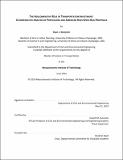| dc.contributor.advisor | Joseph M. Sussman. | en_US |
| dc.contributor.author | Westrom, Ryan J. (Ryan Jeremy) | en_US |
| dc.contributor.other | Massachusetts Institute of Technology. Department of Civil and Environmental Engineering. | en_US |
| dc.coverage.spatial | e-po--- n-us--- | en_US |
| dc.date.accessioned | 2014-09-19T19:37:40Z | |
| dc.date.available | 2014-09-19T19:37:40Z | |
| dc.date.copyright | 2014 | en_US |
| dc.date.issued | 2014 | en_US |
| dc.identifier.uri | http://hdl.handle.net/1721.1/89855 | |
| dc.description | Thesis: S.M. in Transportation, Massachusetts Institute of Technology, Department of Civil and Environmental Engineering, 2014. | en_US |
| dc.description | This electronic version was submitted by the student author. The certified thesis is available in the Institute Archives and Special Collections. | en_US |
| dc.description | Cataloged from student-submitted PDF version of thesis. | en_US |
| dc.description | Includes bibliographical references (pages 167-179). | en_US |
| dc.description.abstract | This research uses a comparative analysis of High-Speed Rail (HSR) impacts from proposals in both Portugal and Illinois to understand the wider economic implications of these proposed transportation links and corollary improvements. Conceptualizing these HSR-linked regions as a string of interconnected cities, the research explores added accessibility in these linked cities and shows HSR time-space effects functionally move some cities into other cities' commuting areas. Here, case studies of four different, but analogous, proposed HSR stops in two countries-Portugal and the United States-reveal various insights. The cities of Coimbra and Leiria in Portugal and Champaign-Urbana and Kankakee in Illinois, with new high-speed access to Lisbon and Chicago, respectively, are analyzed to further explore the potential effects HSR could have on such communities. The research presented takes a complex systems perspective, exploring striking parallels of population and distances between the case communities, and highlights opportunities for these communities afforded by new connections to the principal cities. Ultimately, further understanding potential impacts on local communities involves multiple considerations and provides various transportation planning lessons. This work shows how particular investment will serve to reinforce and potentially accelerate the growth of regions, metropolitan areas, and create new micro-urban centers. Via further market integration into the principal metropolitan areas, economic development and quality of life shifts become possible. Using a conceptual methodological framework to quantitatively assess agglomerative benefits, the research shows that HSR improves the potential for agglomeration growth over the best existing travel mode by approximately 25% to 125% in Portugal and 15% to 150% in Illinois amongst the case communities. | en_US |
| dc.description.statementofresponsibility | by Ryan J. Westrom. | en_US |
| dc.format.extent | 179 pages | en_US |
| dc.language.iso | eng | en_US |
| dc.publisher | Massachusetts Institute of Technology | en_US |
| dc.rights | M.I.T. theses are protected by copyright. They may be viewed from this source for any purpose, but reproduction or distribution in any format is prohibited without written permission. See provided URL for inquiries about permission. | en_US |
| dc.rights.uri | http://dspace.mit.edu/handle/1721.1/7582 | en_US |
| dc.subject | Civil and Environmental Engineering. | en_US |
| dc.title | The agglomerative role of transportation investment : a comparative analysis of Portuguese and American high-speed rail proposals | en_US |
| dc.type | Thesis | en_US |
| dc.description.degree | S.M. in Transportation | en_US |
| dc.contributor.department | Massachusetts Institute of Technology. Department of Civil and Environmental Engineering | |
| dc.identifier.oclc | 890141764 | en_US |
